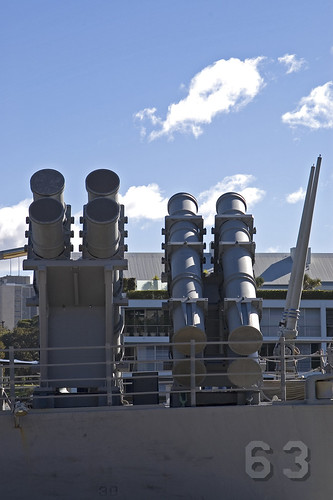Navy Harpoon anti-ship missiles

ATLANTIC OCEAN (April 29, 2009) A Harpoon missile is launched from the guided-missile destroyer USS Donald Cook (DDG 75) during the sinking exercise portion of UNITAS Gold. This year marks the 50th iteration of UNITAS, a multinational exercise that provides opportunities for participating nations to increase their collective ability counter illicit maritime activities that threaten regional stability. Participating countries are Brazil, Canada, Chile, Colombia, Ecuador, Germany, Mexico, Peru, U.S. and Uruguay. (U.S. Navy photo by Mass Communication Specialist Seaman Patrick Grieco/Released)

Even as some Navy commanders quietly worry about the potential threat from foreign anti-ship missiles, fewer American warships have gone to sea in the past decade with anti-ship weapons of their own. But that might change.
The Harpoon is a subsonic active homing anti-ship sea-skimming missile. It provides a long-range attack capability against hostile surface targets.
POINTS:
The Harpoon missile has a range of 70 nautical miles at a speed of 0.9 Mach.
The Harpoon is an all weather "fire and forget" missile with it's own internal guidance that takes the missile all the way to the target.
The ship carries 8 harpoon missiles.
The missile is comparable to the French-made Exocet, the Swedish RBS-15, the Russian SS-N-25 Switchblade, the British Sea Eagle and the Chinese Yingji
The Harpoon anti-ship missiles has also been adapted for use on the F-16 fighter plane, in use by the USA, Singapore, South Korea and the United Arab Emirates. It has been carried by several US Navy aircraft, including the P-3 Orion , the A-6 Intruder, the S-3 Viking, the AV-8B Harrier II jet, and the F/A-18 Hornet.
AGM-84G Harpoon Air-to-surface missile for F-16
Wingspan 3 ft (0.91 m)
Operational
range 58–196 mi (93–315 km) depending on launch platform
Flight altitude Sea-skimming
Speed 537 miles per hour (864 km/h)(240 m/s)
Guidance
system Active radar
Launch
platform multi-platform:
RGM-84A surface-launched
AGM-84A air-launched
UGM-84A submarine-launched
The Defense Advanced Research Projects Agency and the Office of Naval Research issued a $10 million contract to defense giant Lockheed Martin on June 30 to begin work on a “Long Range Anti-Ship Missile.” If the project moves forward, the Navy could begin buying an advanced, high-speed missile that would ride in cruisers’ and destroyers’ Mk 41 Vertical Launch System tubes.
In a statement, DARPA spokeswoman Jan Walker said the goal was to develop a weapon that can think and hunt without much help from its firing ship.
Today, the only anti-ship missile in the surface fleet is the RGM-84 Harpoon, carried in X-shaped racks on the sterns of cruisers and early-model destroyers. The Navy withdrew the anti-ship versions of its BGM-109 Tomahawk missiles in 1995, converting them to the land-attack variant now in cruisers’ and destroyers’ VLS tubes.
Many of today’s newer destroyers have no Harpoon launchers and, as such, no anti-ship missiles. Instead, if the ship needed to sink an enemy ship at long range, it could launch a helicopter armed with Harpoons, AGM-119 Penguins or AGM-114 Hellfire missiles. Attack jets also can carry anti-ship missiles.
U.S. commanders became wary of ship-launched anti-ship missiles in exercises in the 1980s, during which they missed or hit neutral ships about as often as they found their targets, naval weapons expert Norman Friedman said. The weapons suffered from the classic problem of needing good information about their targets.
Friedman said he was skeptical about the prospects for DARPA and ONR’s new missile. Although sensors have gotten better in the age of unmanned aerial vehicles and higher-tech satellites, the classic target-finding problem still remains, he said.
“There are constant efforts to make hypersonic missiles — you see claims about them — but they don’t seem to go anywhere.”
Who has Harpoons?
Newly built Navy surface combatants were outfitted with Harpoon anti-ship missiles until 1999, with the commissioning of the destroyer Porter, the last Flight II Arleigh Burke-class destroyer.
Starting with the first Flight IIA ship, Oscar Austin, the Navy deleted that feature from new destroyers. So that ship through the as-yet-unnamed DDG 115 do not or will not carry Harpoon missiles.
All 22 cruisers carry Harpoons.
No comments:
Post a Comment